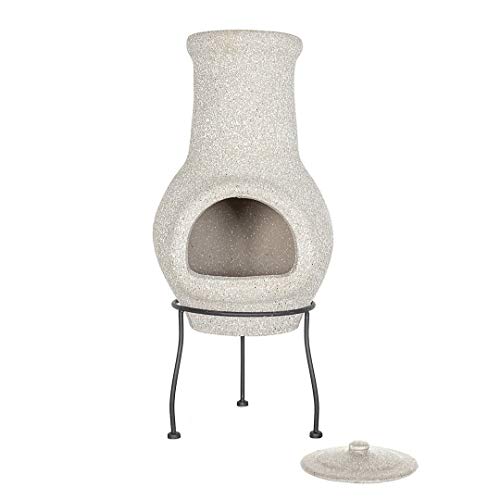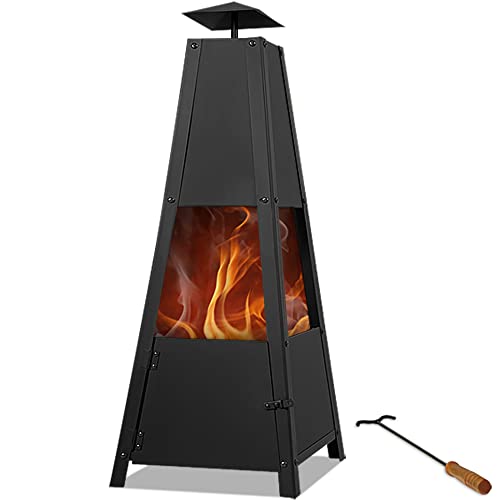25 Amazing Facts About Ceramic Chiminea
페이지 정보
작성자Jim Simcox 댓글댓글 0건 조회조회 20회 작성일 24-11-01 14:47본문
 The Basics of a Ceramic Chiminea
The Basics of a Ceramic ChimineaThe most popular type of chiminea is made of clay. Think of terra cotta pots, or those red pottery ones. Clay is tough and durable, but it can crack when handled improperly.
 Clay is very absorbent, which is why it has to be protected by sand or gravel at the bottom of a chiminea along with logs or kindling. This prevents the clay from getting too hot and prevents hairline cracks from forming.
Clay is very absorbent, which is why it has to be protected by sand or gravel at the bottom of a chiminea along with logs or kindling. This prevents the clay from getting too hot and prevents hairline cracks from forming.Materials
The traditional clay chimineas (also called pot-bellied ovens) have a chimney which sends smoke upwards. These chimineas are coated with glazes to guard them against weathering and cracking caused by sudden temperature changes. However, they are still vulnerable to rain and sun. It is therefore important to cover them when not in use and to prevent water puddles from growing inside the clay.
The majority of chimineas are created from terracotta, however other materials such as cast iron and steel are available. Terracotta provides the classic Mexican look, while cast iron and aluminum are strong alternatives that require less maintenance than the terracotta. Certain manufacturers also offer contemporary designs that blend the beauty of a clay chiminea and the toughness of metal.
Many people choose to pair their chimineas with flowers or evergreen plants. This helps to create a natural look that complements the natural beauty of their backyard. It is crucial to select plants that go together, as a chiminea needs to be placed in an area that is free of overhead structures that could catch fire. It is also crucial to ensure that the chiminea is located on a fire-safe surface, such as brick, concrete or stone patios.
A chiminea can be created by hand using high-fired unglazed clay. The person who creates the clay is known as a potter, and they can throw the piece on a potter's wheel, or using a mould for plaster. In either case, the clay is kneaded prior allowed to dry. Certain chimineas made of clay are pre-grogged as an additive that can help them withstand thermal stresses that are susceptible to cracking traditional earthenware.
Other chimineas are made in molds made of metal, which gives them a variety of styles and shapes to fit any backyard. Cast iron chimineas may be heavier than clay models however they are more durable and less likely to crack or break because of sudden temperature fluctuations. They are less expensive than other kinds of chimineas too, and they come in gas-burning models, too to provide additional versatility.
Styles
A chiminea is a fireplace that can be decorated with a variety styles and materials. Terracotta chimineas feature an elegant appearance that has been used for centuries, while metal chiminea chimineas are more durable and able to handle high temperatures. Many chimineas feature designs and patterns that complement the surrounding furniture for the patio. A rusty finish, for example, can give your chiminea an old-fashioned look, especially if you pair it with wood or iron patio furniture.
Chimineas can be a freestanding structure or a mounted on a patio constructed of stone, brick, or concrete. No matter where you decide to put your chiminea, make sure it is safe from the wind and away from any plant or structure that is flammable. It is important to remember that chimineas can emit smoke and soot which can influence the air quality in the surrounding area.
Certain chimineas have chimneys that open at the lower part of the structure, while others are pointed upwards and squat. Both styles are available with or without a wide opening to accommodate firewood. The chimneys on squat models are able to be designed to give them a an impressive appearance and enhance the visual appeal.
You can also add decorative elements to the outside of your Chiminea such as marble, wrought iron, or granite. Consider a copper or ceramic top for a touch of style. These finishes reflect light and increase the appearance of your chiminea.
A regular chiminea-polish is another method to shield your outdoor fire pit from damage and beautify it. Use beeswax, olive oil or other natural products to polish the surface to give it a rich shining finish. Apply a thin layer and rub gently. Rinse and dry your chiminea to achieve a radiant finish.
Chimineas need a lot of maintenance, but with the right care and attention your creative outdoor chiminea can look fashionable for a long time. By implementing efficient decorating strategies and maintaining your chiminea's condition, you'll be able to enjoy it throughout the colder months.
Safety
Although chimineas are a popular choice however they could pose an injury risk if properly used. Clay chimineas, particularly ones that are not glazed, are susceptible to cracking and breaking. They also pose an ignition source in proximity to flammable materials like your home, furniture outdoors, and the garden. You should only use a chiminea outdoors and in an area that is enclosed or surrounded by fire-proof materials.
You should always keep a fire extinguisher close by and use it when needed to extinguish small chiminea flames or hot coals that may occur while you are tending the flame. It is also an excellent idea to use a long lighter to light your fire chiminea and to move coals around using tongs instead of using your hands. A bucket of water is also a good thing to have near by in case the chiminea has to be extinguished. It is not recommended to use water to extinguish the chiminea's fire after it has been cooled. Instead, add water only when the fire has died down or when the chimney is at risk of bursting.
The draft that is created by a chiminea could carry sparks upward through the stack, so it is important to protect your home and neighbors from accidental burns with a simple spark arrestor made of chicken wire positioned around the top of the stack. Chimineas can also become extremely hot, and the area around them. You should install a low wall to warn people not to step too close to.
Don't burn your chiminea when it's rainy or windy conditions. The sparks could cause a chimney to catch fire and cause damage to your home. Make sure to inquire with the local fire department if there are any burn restrictions in place prior to using the chimney. Before adding firewood to your chiminea extra large, it is recommended to clean the area around it. This will ensure that there aren't any flammable materials within the vicinity. It is also an excellent idea to clean the interior of your chiminea following each use to prevent ash buildup that can lead to smoke inhalation and an ashy exterior.
Maintenance
Despite the fact that they can be used for outdoor fires clay chimineas aren't easy to maintain devices. Like all things made from clay, they require being treated with an appropriate amount of care to guarantee their longest life. It is important to not allow them to get too hot and allow them to cool between use. They should also be regularly sanded and sealed to keep the paint from being damaged.
The first step to keep your chiminea in good shape is to remove the ashes from it after each use, but only once it has completely cooled down. It will be warm even though it appears to have cooled down, so use an ice breaker and a brush to clear away the ash. After you have cleaned the ash away and cleared of it with care the next step is to fill the bottom with either gravel or sand. If you do not fill it your chiminea might crack. This is due to the fact that clay absorbs water and can crack if it gets too dry.
Some sources recommend treating the exterior of a chiminea with an acrylic waterproofing solution, similar to the ones used to seal tiles. This can prevent moisture from seeping into the chiminea and causing damage to it. During periods of heavy use it is recommended to remove the chiminea and sand it every 6-8 weeks.
Chimineas should only be burned on clean, safe surfaces and they should never be placed on wood decking or on any other kind of overhead covering. Only using hardwood that has been well-seasoned will reduce the number of sparks and also prevent the clay from cracking.
A chiminea made of clay will not last for long. However it is very not a problem to break unless hit it with the force of a Hammer. Cracks can occur due to a variety of reasons, such as poor burning or the lack of proper maintenance. They also have the potential to rust, and should be covered whenever not in use. This will keep rain and snow from corroding Metal chiminea parts.
댓글목록
등록된 댓글이 없습니다.

